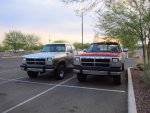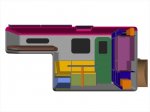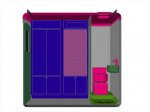Nitromethane43
Observer
Hello Everyone,
I am back in the process of working a composite camper body that will reside either on a first or second generation Dodge 3/4 pickup truck. The goal is to have a smallish camper with regular accommodations for two people traveling down to Panama, and beyond. I have tried to keep everything as close to the original footprint as possible, as it's been difficult in some places of Mexico driving the truck without a camper on the back.
The construction method would be a 2" structural foam core with fiberglass skins on either side, I have seen a few people go about using this construction method, one was with pink insulation board on a newer Toyota or Nissan truck and S2DM has made parts of his camper with this. It does take quite a bit of labor to get together compared to any panel system, but the budget does not work well using the prefab panels.
Here are some preliminary specifications:
Floor Length: 104"
Overall Length: 168"
Exterior Width: 86"
Interior Width: 82"
Exterior Height: 82" > May reduce to 76"
Interior Height: 78" > May reduce to 72"
Fresh Water: 50 Gal
Grey Water: 30 Gal
Solar Capacity: 640 Watts
CALB 400Ah Capacity Battery
2000w Victron Inverter Charger
Morning Star Tristar MPPT Charger
Blue Sea Systems Electrical Panel
Diesel Hydronic Heating w/ 11gal tank
Dometic Saneo Toilet
Nova Kool RFU8320 Fridge
Windows: Hehr 6400 or Motion Windows 1275
Below are some working concept drawings:

One of the possible contenders

Exterior View

Plan View

Interior 1

Interior 2

Interior 3

Interior 4

Section

Frame
If there is anyone with some advice I be pleased to hear what you have to say, some questions prior to going into the design stage are:
1. I would like to lower the overall height and have the interior at 72" tall, that works fine for me as there is still some head room, but does living in a camper with low head room increase discomfort over the long run? And does anyone that has a low camper wish for more head room after a short period.
2. What is a good working cab over clearance over a truck with a open C-Channel frame say earlier trucks without causing any rubbing issues while on rough roads, not any serious rock climbing, but say going over ledges or ditches.
3. All over on the RV forums people have complained about the Hehr 6400 flush mount insulated windows fogging up and being really expensive to fix due to the frame less design. Healeyjet seems to have chosen these windows for a build, is there anyone with experience on these windows, they look great, but do not want to spend a fortune on them and then have to fork over another to get them repaired when fogged up. The alternative is to go with Motion Windows 1275 Marine windows that are insulated but have standard frames and can be swapped out with 1/2" plastics if fogging becomes an issue.
4. For people that have gone the full composite route what form of attachment is used on the camper to chassis connection? I was thinking of glassing in two fiberglass rails on the bottom of the camper similar to stingers on a boat, then bonding them onto a steel frame which will get mounted to the chassis, it there an better method which could eliminate the frame and lower the overall height?
5. Has anyone come upon a good alternative to wood materials for the interior fit out and cabinetry, It would be preferred to not have any wood in this build, Corsa Board seems very expensive, Sintra PVC is a light weight contender, and Starboard is fairly heavy for full cabinetry.
I am back in the process of working a composite camper body that will reside either on a first or second generation Dodge 3/4 pickup truck. The goal is to have a smallish camper with regular accommodations for two people traveling down to Panama, and beyond. I have tried to keep everything as close to the original footprint as possible, as it's been difficult in some places of Mexico driving the truck without a camper on the back.
The construction method would be a 2" structural foam core with fiberglass skins on either side, I have seen a few people go about using this construction method, one was with pink insulation board on a newer Toyota or Nissan truck and S2DM has made parts of his camper with this. It does take quite a bit of labor to get together compared to any panel system, but the budget does not work well using the prefab panels.
Here are some preliminary specifications:
Floor Length: 104"
Overall Length: 168"
Exterior Width: 86"
Interior Width: 82"
Exterior Height: 82" > May reduce to 76"
Interior Height: 78" > May reduce to 72"
Fresh Water: 50 Gal
Grey Water: 30 Gal
Solar Capacity: 640 Watts
CALB 400Ah Capacity Battery
2000w Victron Inverter Charger
Morning Star Tristar MPPT Charger
Blue Sea Systems Electrical Panel
Diesel Hydronic Heating w/ 11gal tank
Dometic Saneo Toilet
Nova Kool RFU8320 Fridge
Windows: Hehr 6400 or Motion Windows 1275
Below are some working concept drawings:

One of the possible contenders

Exterior View

Plan View

Interior 1

Interior 2

Interior 3

Interior 4

Section

Frame
If there is anyone with some advice I be pleased to hear what you have to say, some questions prior to going into the design stage are:
1. I would like to lower the overall height and have the interior at 72" tall, that works fine for me as there is still some head room, but does living in a camper with low head room increase discomfort over the long run? And does anyone that has a low camper wish for more head room after a short period.
2. What is a good working cab over clearance over a truck with a open C-Channel frame say earlier trucks without causing any rubbing issues while on rough roads, not any serious rock climbing, but say going over ledges or ditches.
3. All over on the RV forums people have complained about the Hehr 6400 flush mount insulated windows fogging up and being really expensive to fix due to the frame less design. Healeyjet seems to have chosen these windows for a build, is there anyone with experience on these windows, they look great, but do not want to spend a fortune on them and then have to fork over another to get them repaired when fogged up. The alternative is to go with Motion Windows 1275 Marine windows that are insulated but have standard frames and can be swapped out with 1/2" plastics if fogging becomes an issue.
4. For people that have gone the full composite route what form of attachment is used on the camper to chassis connection? I was thinking of glassing in two fiberglass rails on the bottom of the camper similar to stingers on a boat, then bonding them onto a steel frame which will get mounted to the chassis, it there an better method which could eliminate the frame and lower the overall height?
5. Has anyone come upon a good alternative to wood materials for the interior fit out and cabinetry, It would be preferred to not have any wood in this build, Corsa Board seems very expensive, Sintra PVC is a light weight contender, and Starboard is fairly heavy for full cabinetry.
Last edited:





